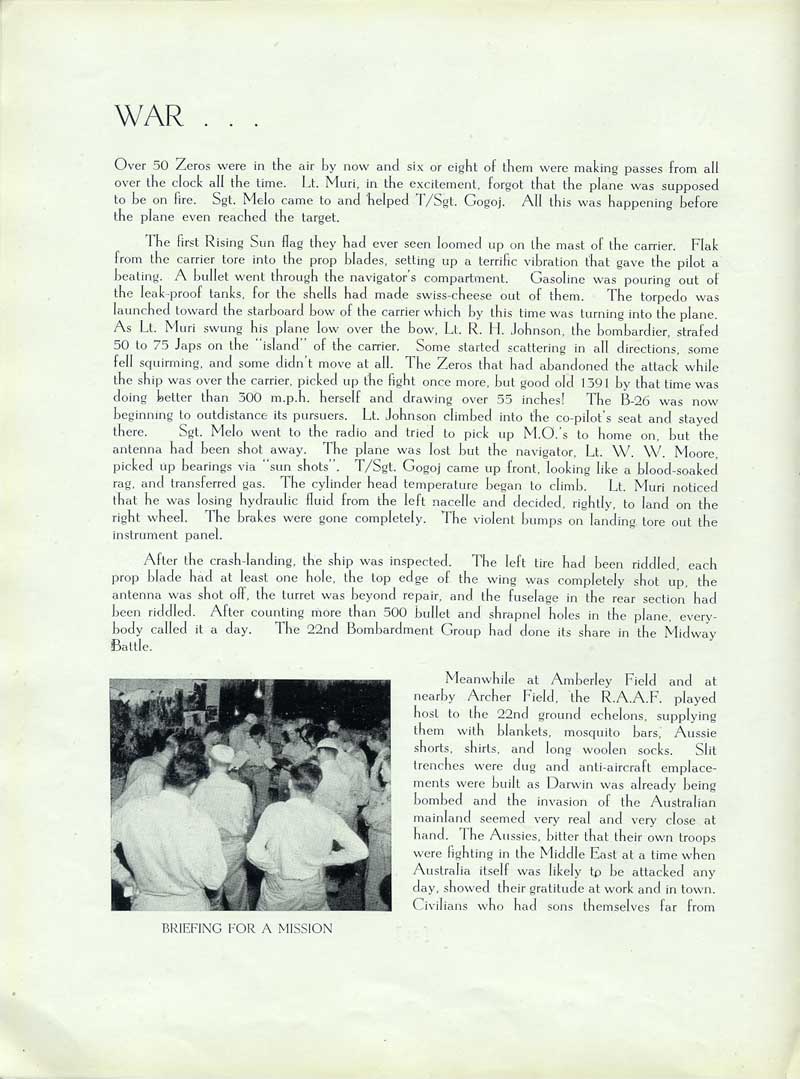
Next page...

| WAR ... Over 50 Zeros were in the air by now and six or eight of them were making passes from all over the clock all the time. Lt. Mori, in the excitement, forgot that the plane was supposed to be on fire. Sgt. Melo came to and Helped T/Sgt. Gogoj. All this was happening before the plane even reached the target. The first Rising Sun flag they had ever seen loomed up on the mast of the carrier. Flak from the carrier tore into the prop blades, setting up a terrific vibration that gave the pilot a beating. A bullet went through the navigator's compartment. Gasoline was pouring out of the leak proof tanks, for the shells had made swiss-cheese out of them. The torpedo was launched toward the starboard bow of the carrier which by this time was turning into the plane. As Lt. Muri swung his plane low over the bow, Lt. R. H. Johnson, the bombardier, strafed 50 to 75 Japanese on the "island" of the carrier. Some started scattering in all directions, some fell squirming, and some didn't move at all. The Zeros that had abandoned the attack while the ship was over the carrier, picked up the fight once more, but good old 1391 by that time was doing better than 300 m.p.h. herself and drawing over 55 inches! The B-26 was now beginning to outdistance its pursuers. Lt. Johnson climbed into the co-pilot's seat and stayed there. Sgt. Melo went to the radio and tried to pick up M.O.'s to home on, but the antenna had been shot away. The plane was lost but the navigator, Lt. W. W. Moore, picked tip bearings via "sun shots". T/Sgt. Gogoj came up front, looking like a blood-soaked rag, and transferred gas. The cylinder head temperature began to climb. Lt. Muri noticed that he was losing hydraulic fluid from the left nacelle and decided, rightly, to land on the right wheel. The brakes were gone completely. The violent bumps on landing tore out the instrument panel. After the crash-landing, the ship was inspected. The left tire had been riddled, each prop blade had at least one hole, the top edge of the wing was completely shot up, the antenna was shot off, the turret was beyond repair, and the fuselage in the rear section had been riddled. After counting more than 500 bullet and shrapnel holes in the plane, everybody called it a day. The 22nd Bombardment Group bad done its share in the Midway Battle. Meanwhile at Amherley Field and at nearby Archer Field, the R.A.A.F. played host to the 22nd ground echelons, supplying them with blankets, mosquito bars, Aussie shorts, shirts, and long woolen socks. Slit trenches were dug and anti-aircraft emplacements were built as Darwin was already being bombed and the invasion of the Australian mainland seemed very real and very close at hand. The Aussies, bitter that their own troops were fighting in the Middle East at a time when Australia itself was likely to be attacked any day, showed their gratitude at work and in town. Civilians who had sons themselves far from |